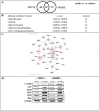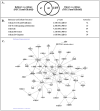Astrocytes enhance the invasion potential of glioblastoma stem-like cells
- PMID: 23349962
- PMCID: PMC3551925
- DOI: 10.1371/journal.pone.0054752
Astrocytes enhance the invasion potential of glioblastoma stem-like cells
Abstract
Glioblastomas (GBMs) are characterized as highly invasive; the contribution of GBM stem-like cells (GSCs) to the invasive phenotype, however, has not been completely defined. Towards this end, we have defined the invasion potential of CD133+ GSCs and their differentiated CD133- counterparts grown under standard in vitro conditions and in co-culture with astrocytes. Using a trans-well assay, astrocytes or astrocyte conditioned media in the bottom chamber significantly increased the invasion of GSCs yet had no effect on CD133- cells. In addition, a monolayer invasion assay showed that the GSCs invaded farther into an astrocyte monolayer than their differentiated progeny. Gene expression profiles were generated from two GSC lines grown in trans-well culture with astrocytes in the bottom chamber or directly in contact with astrocyte monolayers. In each co-culture model, genes whose expression was commonly increased in both GSC lines involved cell movement and included a number of genes that have been previously associated with tumor cell invasion. Similar gene expression modifications were not detected in CD133- cells co-cultured under the same conditions with astrocytes. Finally, evaluation of the secretome of astrocytes grown in monolayer identified a number of chemokines and cytokines associated with tumor cell invasion. These data suggest that astrocytes enhance the invasion of CD133+ GSCs and provide additional support for a critical role of brain microenvironment in the regulation of GBM biology.
Conflict of interest statement
Figures






Similar articles
-
CD133+ glioblastoma stem-like cells induce vascular mimicry in vivo.Curr Neurovasc Res. 2011 Aug 1;8(3):210-9. doi: 10.2174/156720211796558023. Curr Neurovasc Res. 2011. PMID: 21675958
-
The brain microenvironment preferentially enhances the radioresistance of CD133(+) glioblastoma stem-like cells.Neoplasia. 2012 Feb;14(2):150-8. doi: 10.1593/neo.111794. Neoplasia. 2012. PMID: 22431923 Free PMC article.
-
Enhanced invasion in vitro and the distribution patterns in vivo of CD133+ glioma stem cells.Chin Med J (Engl). 2011 Sep;124(17):2599-604. Chin Med J (Engl). 2011. PMID: 22040410
-
Glioblastoma cancer stem cells--from concept to clinical application.Cancer Lett. 2013 Sep 10;338(1):32-40. doi: 10.1016/j.canlet.2012.05.033. Epub 2012 Jun 2. Cancer Lett. 2013. PMID: 22668828 Review.
-
CD133 as a marker for regulation and potential for targeted therapies in glioblastoma multiforme.Neurosurg Clin N Am. 2012 Jul;23(3):391-405. doi: 10.1016/j.nec.2012.04.011. Epub 2012 Jun 5. Neurosurg Clin N Am. 2012. PMID: 22748652 Review.
Cited by
-
Targeting Neuroinflammation in Brain Cancer: Uncovering Mechanisms, Pharmacological Targets, and Neuropharmaceutical Developments.Front Pharmacol. 2021 May 18;12:680021. doi: 10.3389/fphar.2021.680021. eCollection 2021. Front Pharmacol. 2021. PMID: 34084145 Free PMC article. Review.
-
The multiple faces of extracellular vesicles released by microglia: Where are we 10 years after?Front Cell Neurosci. 2022 Sep 13;16:984690. doi: 10.3389/fncel.2022.984690. eCollection 2022. Front Cell Neurosci. 2022. PMID: 36176630 Free PMC article. Review.
-
Multidimensional communication in the microenvirons of glioblastoma.Nat Rev Neurol. 2018 Aug;14(8):482-495. doi: 10.1038/s41582-018-0025-8. Nat Rev Neurol. 2018. PMID: 29985475 Free PMC article. Review.
-
Modeling the tumor microenvironment using chitosan-alginate scaffolds to control the stem-like state of glioblastoma cells.Biomater Sci. 2016 Apr;4(4):610-3. doi: 10.1039/c5bm00514k. Epub 2015 Dec 21. Biomater Sci. 2016. PMID: 26688867 Free PMC article.
-
Coculture with astrocytes reduces the radiosensitivity of glioblastoma stem-like cells and identifies additional targets for radiosensitization.Cancer Med. 2015 Nov;4(11):1705-16. doi: 10.1002/cam4.510. Epub 2015 Oct 30. Cancer Med. 2015. PMID: 26518290 Free PMC article.
References
-
- Stupp R, Hegi ME, Mason WP, van den Bent MJ, Taphoorn MJ, et al. (2009) Effects of radiotherapy with concomitant and adjuvant temozolomide versus radiotherapy alone on survival in glioblastoma in a randomised phase III study: 5-year analysis of the EORTC-NCIC trial. Lancet Oncol 10: 459–466. - PubMed
-
- Singh SK, Hawkins C, Clarke ID, Squire JA, Bayani J, et al. (2004) Identification of human brain tumour initiating cells. Nature 432: 396–401. - PubMed
-
- Galli R, Binda E, Orfanelli U, Cipelletti B, Gritti A, et al. (2004) Isolation and characterization of tumorigenic, stem-like neural precursors from human glioblastoma. Cancer Res 64: 7011–7021. - PubMed
-
- Singh SK, Clarke ID, Terasaki M, Bonn VE, Hawkins C, et al. (2003) Identification of a cancer stem cell in human brain tumors. Cancer Res 63: 5821–5828. - PubMed
Publication types
MeSH terms
Substances
Grants and funding
LinkOut - more resources
Full Text Sources
Other Literature Sources
Medical
Research Materials

